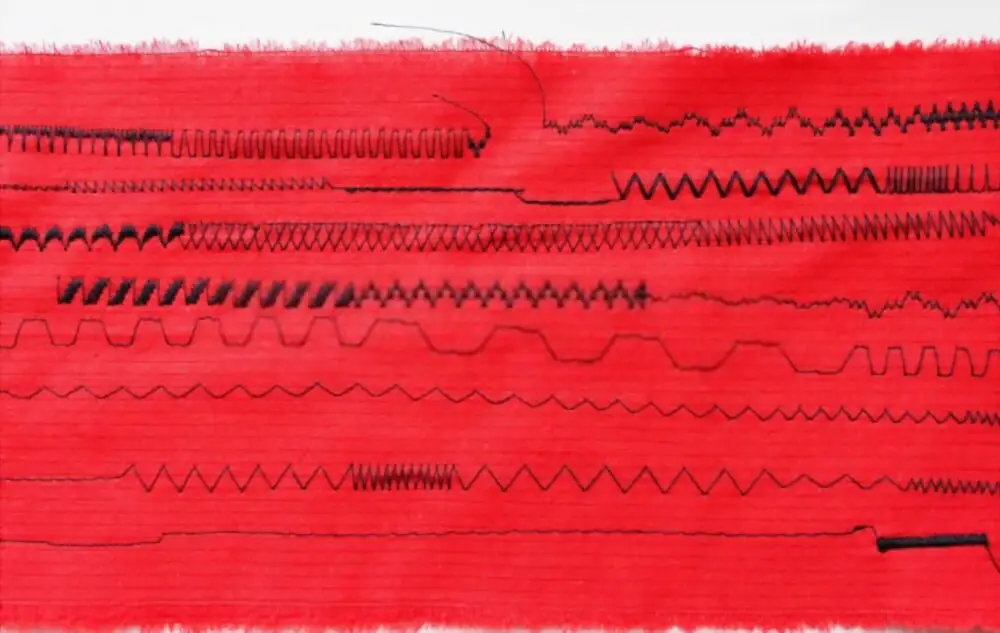This article will show you how to stop fabric from fraying. Frayed fabric can be a major annoyance, but with a few simple steps, you can keep your clothes looking great.
Do you find yourself constantly fighting with fabrics? It can be frustrating when your clothing starts coming apart at the seams. All is not lost though!
There are several things that may help keep those pesky threads from dragging on everything around them or getting caught up in cracks, such as sewing machines and overlockers–here’s what we know so far about how they work their magic.
What Is Fraying?
The process of fraying is what happens when a fabric edge slowly unravels. The very edges get loose from their main body and work their way up towards seams or shrinkage in the item itself.
Fraying can be caused by any one thing but there are two different ways you could stop it: sewn finishes (like zigzag stitch), which have been used since before World War II; no-sew finishes like serging that was popularized around the 1950s for use on nylon because its tough nature meant more physical abuse than other fabrics
What Is A Sew Fabric Finish?
A sewn finish is the most common form of binding. It’s used for thick fabrics and fabrics that will be washed frequently, like clothing or homeware items. The fabric edge can also include another material to encase it so as not to fray when exposed raw edges after being cut from a roll(or bolt).
When To Use A Sew Fabric Finish?
There are plenty of times you can use a sewn fabric finish. The most common use for this technique is on clothing since the friction and movement often cause unraveling, and fraying garments in time no matter how careful we try to be when sewing them up from beginning to end.
It may look bulky or messy depending upon what style your garment has; however with some work it’s not impossible to make sure there are hidden seams that will take away any bulkiness while maintaining an elegant appearance by keeping things tidy underneath instead!
What Is A No Sew Fabric Finish?
A no-sew fabric finish is when a piece of fabric isn’t hemmed or bound by sewing. The edge can be finished in many different ways, including burning it with an iron and gluing the raw edges together for added strength.
A nuSeveralbeforeare used to create this type of finishing such as gluing down zigzag stitches overlockers folded hems which all count as examples that fit into the “sew” category but don’t necessarily need any actual sewing talent!
When To Use A No Sew Fabric Finish?
The best times to use a no-sew fabric finish are with tricky fabrics that are hard to work and their seams, or if you want an edge without the hassle.
These techniques won’t fray your project as much because it comes into less friction but be careful when doing so since these finishes can’t cover large areas like clothing do– only smaller projects such as homeware pieces might benefit from this kind of treatment!
How To Stop Fraying In Fabric
To stop the fabric from fraying, you can work on a few different techniques. There are ways that the fabric will not fray with sewing machines and without one as well!
Sew Finish
- Widen Seams
- Sew French Seams
- Interfacing
- Pinking Shears
- Zig-Zag Stitch
- Hand-stitch
- Overlocked Edge
- Bias Tape

1. Widen Seams
To avoid the risk of having any frayed edges, it is important to cut sheer fabrics with a wider seam allowance.
For example: If you add on an extra 3/8″ and change your seams from 5/8” (1.5cm)to 1″ (2.5 cm), this allows for some ruffled fabric when sewn together after wearing or washing since there will be less material being pulled tight at either end by these tighter stitch lines which can cause them to open up quicker than one without those modifications made in advance!
2. French Seam
A french seam is a popular finishing technique for clothing that keeps the garment’s fabric from fraying.
It creates an intense edge of encasing one side in another, neatens both ends, and prevents raw edges from streaking or unraveling- all while keeping lightweight apparel light as if they were made out of paper!
3. Interfacing
Iron-on fusible interfacing is a great way to stop the fabric from fraying. Precut narrow strips of this material and sew them onto your seams prior to turning, giving you the most secure finish possible!
4. Pinking Shears
Pinking shears are a great way to stop fraying on your favorite fabrics like cotton and crisp ones.
You must use them when working with tighter weaves, but loose-woven materials may still be affected by this type of cutter so keep something else handy in case things go awry!
5. Zig-Zag Stitch
A zig-zag stitch is similar to the overlocker/serger but much simpler.
This can be done on any standard sewing machine and works well, as it creates a wrap-over edge that helps stop fabrics from fraying away!
6. Handstitch
Hand-stitching is a time-consuming process, but if you have thick materials like a canvas that won’t go through your sewing machine easily then this technique will be best for you.
7. Overlocked Edge
An overlocked edge or a serger stitch is done on an overlocker/serger. This passes the raw fabric edge through the machine, trimming and then binding it in what feels like magical complex loops that prevent fraying no matter how much you stretch your clothes!
8. Bias Tape
Bias tape can be a great way to stop your fabric edges from fraying. It’s like bias binding, but with an extra step in it!
The casing will often get bulkier than regular sewing and is usually sewn onto the edge of whatever you’re making so that no raw threads are showing when it is all done – which helps keep things clean-looking too 🙂
No-Sew Finish
A no-sew finish is an edge you can use on fabrics that don’t involve a sewing machine or cutting threads with scissors.
These are some of the most popular ways to stop the fabric from fraying without having to go through all those steps in between, such as hemming and serging which take up so much time!
1. Nail Polish
Nail polish is an easy, quick, and effective way to stop the fabric from fraying. It’s also useful for neatening any edges that might be difficult with your sewing machine or serger Blunt cutters can easily remove excess material before cutting so it doesn’t create a lumpy finish on your finished project.
You need just paint the clear brush across the seam where there’s been some wear downrange then run small sections up each side smoothly but not too quickly to get even coverage; let dry fully beforehand if possible as this technique works best when left overnight!
2. Burning Edges ( Synthetic Fabrics Only)
This technique will only work on synthetic fabrics, as it melts the fibers. Any other fabric would be set on fire and unfortunately, be lost or ruined by this process (burning).
However, for trimming edges such as plastic boning and anything longer than 1 inch in length – you may want to consider using a lighter instead!
A test piece over your chosen material can check whether they’re 100% polyester before moving onto real-life projects with these instructions; if not then don’t worry about clogging up any sinks etc., just use caution when applying flame near its edge(s) since we know there isn’t much difference between cotton/linen cloth.
3. Fabric Pinking Shears
Pinking shears are a versatile tool that can be used for both lights- Domestic and heavy-duty Commercial sewing. I got my first pair of pinking scissors at university, they were perfect for cutting up samples to save them later on as sketches!
I wouldn’t suggest using this method for clothing because it can still cause the fabric to fray, even if you’ve worn an item. It’s also best not to wash and iron your clothes as those processes provoke more fraying in these seams – which may leave them vulnerable.
However, I find that open-weave fabrics are perfect candidates given they don’t need visible stitching on each side or any fancy sewing at all!
3. Iron-On Adhesive Hem Tape
This is an extremely helpful way to stop the fabric from fraying as it holds the fibers in place. The glue substance of iron-on adhesive works with them and restricts movement which ultimately results in no more unraveling or snagging!
You can use this for hemming garments like trousers, but also handy if you want a neat seam without any stitch lines on your clothing piece too (like jeans).
The adhesive tape won’t work well with sheer to very light fabrics as the glue melts through to the right side of the fabric leaving a horrid block line.
It also will be difficult to use on garments that need plenty of drape and flow, since stiffness is created in this which would ruin their look!
Some Last Words
This is a long list of techniques to stop your fabric from fraying. I hope it helps and if you have any more ideas that work for you, please share them with me!

Robert Patricia
Robert Patricia is a data analytic and content creator. He has worked extensively with large data sets to glean insights for both public and private sector clients. He has used this knowledge to create compelling content for brands across the internet. Albert also enjoys creating content for websites and social media. He is an expert at creating catchy headlines and understands how to capture the attention of readers.
